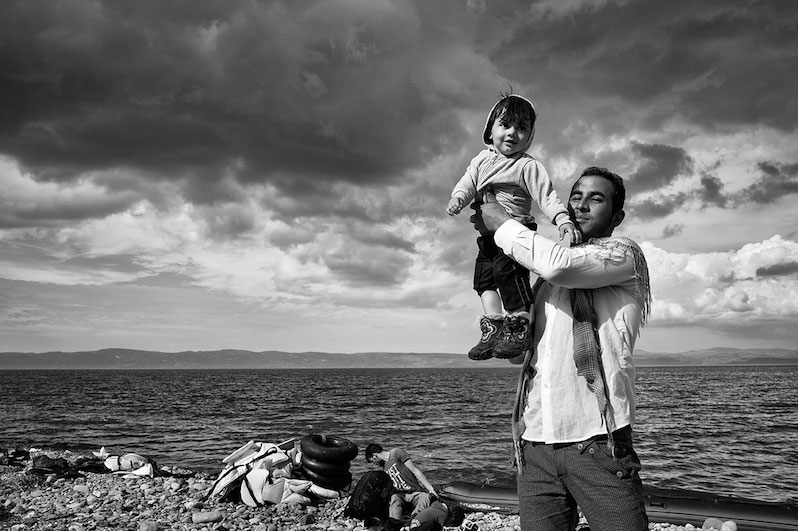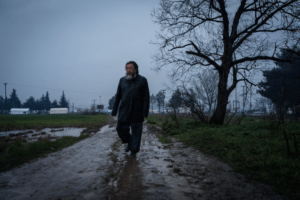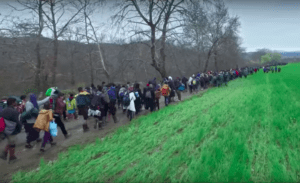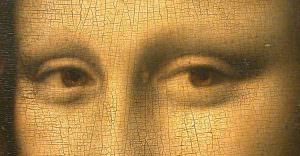Powerful Exhibits on Both Coasts Explore Borders and the Plight of Refugees
Artists at galleries in Los Angeles and New York zoom in on some of the world’s 60,000 displaced people—and one “solution” for dealing with them. A father celebrates his family’s safe passage to Lesbos, Greece after a stormy crossing over the Aegean Sea from Turkey. (Tom Stoddart)
A father celebrates his family’s safe passage to Lesbos, Greece after a stormy crossing over the Aegean Sea from Turkey. (Tom Stoddart)
A father celebrates his family’s safe passage to Lesbos, Greece after a stormy crossing over the Aegean Sea from Turkey. (Tom Stoddart)
The global refugee crisis and proposed plans for a new, improved and costly wall along the U.S. Mexico border have been hotly debated topics this presidential campaign cycle. Along with Donald Trump, Pope Francis and Bono, artists are weighing in on these contentious issues with their creative interpretations and viewpoints.
The plight of migrants and their journey to resettlement is being explored in exhibitions entitled “Refugee,” and “New Americans” at the Annenberg Space for Photography in Los Angeles. One hundred photos commissioned from five acclaimed photographers document the ongoing crisis in countries such as Greece, Germany, Serbia, Mexico, Croatia, Cameroon and Bangladesh.
One of the featured photographers, the twice-kidnapped American photojournalist Lynsey Addario, traveled to Myanmar to document the persecution of the Rohingya people, an ethnic Muslim group in the predominately Buddhist country. In 2015, Addario’s visit to Lebanon exposed the daily life of Hanaa, a 12-year-old Syrian girl, who fled the civil war with her family in 2011. They currently reside in a tented settlement, working 10-hour days on Lebanese-owned land for $5 a day.
The theme of barriers and borders continues at apexart in New York City, with the bilingual group exhibition, “Fencing in Democracy.” Fourteen artists, activists, architects and anthropologists have created works centered on the U.S.-Mexico border wall. Several artists have ties with the region around the wall, bringing a personal aspect to the art.
Arizona artist Alfredo J. Quiroz draws attention to the existential aspects of border crossing with a sculpture of a plastic water jug and a skull and crossbones, signifying death via dehydration. Sadly, this is what happens when temperatures in the desert reach as high as 111 degrees.
Alternative designs by architects Ronald Rael and James Brown offer a repurposing of the wall, built with solar panels to produce green energy, and a friendlier version of Friendship Park, with bike and hiking trails. The current park, along the San Diego-Tijuana border, is heartbreaking; imagine a much larger version of a glass partition in a prison visiting room—except it’s 18 feet tall and made of layers of metal.
“What is the role of art and architecture in providing a bulwark against the erosion of democracy that border walls represent?” is the question posed by curators Miguel Diaz-Barriga and Margaret Dorsey, professors of anthropology at the University of Texas, Rio Grande. The couple has been studying the border wall and its effects on the landscape, ecosystem and residents of south Texas since 2008.
“It was an amazing opportunity to study that moment of political mobilization,” said Dorsey, referring to how 95 percent of the region’s population came together to fight the construction. “At same time, it was kind of a tragic tale, because it showed how democracy didn’t seem to work.”
Dorsey is referring to Congress granting former Secretary of Homeland Security Michael Chertoff the ability to waive any and all laws necessary for the construction of the border wall in 2008. “In total, he waived 37 laws to build the walls,” she said.
“In this area of Texas, the border wall is not actually on the international boundary,” said Diaz-Barriga. “It’s two miles north of the Rio Grande River, so it was cutting through thriving communities, private property, a nature preserve, a university campus and a butterfly park.”
To give an idea of what a portion of the real wall is like, hanging from ceiling in the gallery space at apexart will be two 16-foot panels. That’s two feet shorter than the actual border wall. On the panels are photos taken by Scott Nichol of actual hand- and footprints made by people climbing the wall.
Then there’s Maurice Sherif’s black-and-white photographs of various sections of the billion-dollar wall that meanders 2,000 miles from the Pacific Ocean in California to the Gulf of Mexico in Texas. Some photos allow you to see side-by-side comparisons of the old wall and the new wall. Sherif, a fine-art photographer from France, has been photographing the wall since 2006. He believes the barrier is a misguided project driven by fear, and the millions of dollars already spent on the wall could be put to better use.
These exhibits represent just two examples of how artists around the world have been addressing the refugee crisis in their work. Last December, guerilla street artist Banksy addressed negative attitudes toward the thousands of people living in a refugee camp in Calais, France, with his mural of Steve Jobs, the son of a Syrian immigrant, carrying a computer and a knapsack with his belongings slung over his shoulder.
In February, Chinese artist and human rights activist Ai Weiwei wrapped 14,000 salvaged, orange, refugee life jackets around the columns of Konzerthaus Berlin, the German city’s concert hall.
As for the impact of photography, the now-iconic photos of a 3-year-old Syrian boy washed up on the shore of a Turkish beach and a crying migrant father clutching his children after nearly drowning while crossing the sea to the Greek Island of Kos helped many people far removed from the situation to understand its gravity.
Support for refugees began to wane as masses of uncontrolled migrants seeking asylum flooded into Europe, overwhelming shelters and government resources. According to the United Nations Refugee Agency, UNHCR, the number of displaced people globally has reached 60 million across five continents.
Your support matters…Independent journalism is under threat and overshadowed by heavily funded mainstream media.
You can help level the playing field. Become a member.
Your tax-deductible contribution keeps us digging beneath the headlines to give you thought-provoking, investigative reporting and analysis that unearths what's really happening- without compromise.
Give today to support our courageous, independent journalists.






You need to be a supporter to comment.
There are currently no responses to this article.
Be the first to respond.